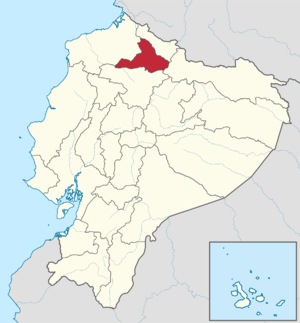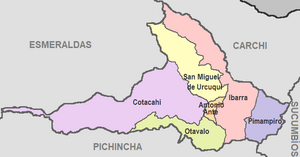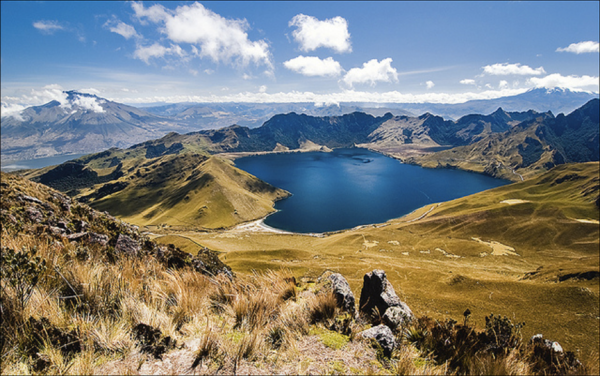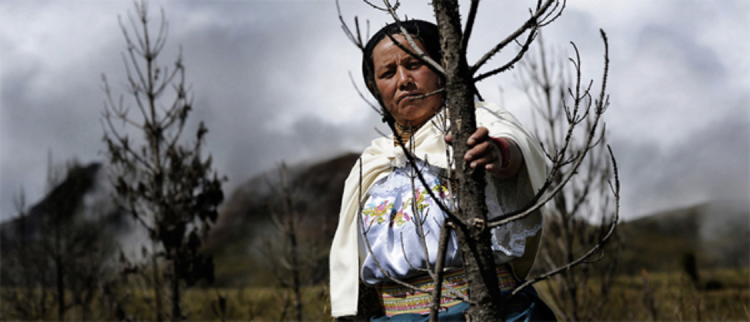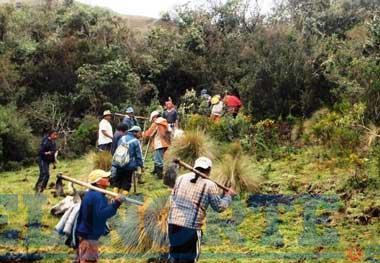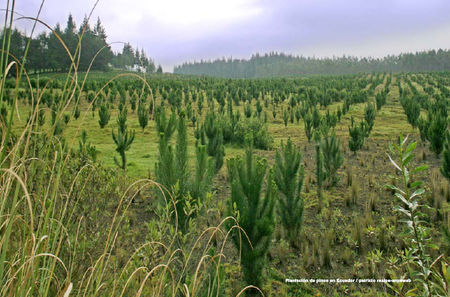Course:FRST270/Wiki Projects/The Paramo global carbon markets and community forestry gone awry the case of the Mojandita Pine Plantation, Ecuador
The Páramo, Global Carbon Markets, and Community Forestry gone awry: The case of the Mojandita Pine Plantation, Ecuador
Summary
In 1990, a consortium of Dutch electricity companies created the Forest Absorbing Carbon Dioxide Emissions Foundation (FACE) to offset the expected carbon emissions of a new coal-fired electric plant to be built in the Netherlands. Around this time, FACE established a branch in Ecuador –PROFAFOR– which contacted the indigenous community of Mojandita in the northern Ecuadorian highlands. The establishment of a 350-acre monoculture pine plantation, a non-native genus to all of the South-American territory, was accorded with the community, and replaced a high altitude Páramo grassland ecosystem. Twenty years from this initial agreement, the promises of sustainable development never materialized. Not only did the community end up losing economic resources out of it, but the negative social and environmental impacts from planting pine trees have persisted to this day. The pine plantation was consumed by a fire on 2003, yet PROFAFOR’s legacy of exploitation, cultural appropriation and terrible ecological practices were molded to portray a particular international public image with which to serve its commercial motivation on the international carbon market.
Description of the Community Forestry Case Study
The 1990s saw emerging environmental concerns in public opinion as well as increases in contempt towards the indiscriminate use of fossil fuels and non-renewable natural resources. During the time, environmental protection is said to have been a top priority in the agenda of European countries as long as the European community remained prosperous [1]. Under this general context, it was precisely in the year of 1990 that a consortium of Dutch electricity companies undertook plans to build a new coal-fired electric power plant [2]. It is to this day the most abundant fossil fuel resource on the planet, coal is a widely used energy source despite its high carbon dioxide emitting nature, with many European countries –The Netherlands and Germany for example– still struggling to phase it out from their energy matrix. As the new coal plant project was to represent millions of tons of carbon dioxide released into the atmosphere and due to the costs involved, they turned to the establishment of tree plantations in developing countries [3].
Thus, in an apparent attempt to divert public criticism from the creation of yet another coal power plant in Europe, the consortium created the Forest Absorbing Carbon Dioxide Emissions (FACE) Foundation. Which had the initial ambitious goal to offset the emissions of the new power plant by the plantation of 150,000 hectares of trees around the world [3]. Although ultimately the plant was not built, FACE continued to invest in carbon offset projects and sell the carbon credits to other corporations and individuals [4]. Taking into consideration burgeoning environmental concerns without neglecting economic prosperity, the creation of FACE seemed to be a clever solution at the time. A market-based approach for the negative externalities of industrialization and production. The Dutch companies’ innovative solution seems to be very much in line with the mechanisms behind the contemporary carbon market or PES (Payment for Ecosystem Services) schemes.
The transnational nature of PES schemes and today’s carbon market made FACE establish contact with the private enterprise PROFAFOR to administer its carbon offsetting plantations in Ecuador [2]. This Ecuadorian company is still active and dedicated to supporting the establishment and management of forestry plantations for carbon sequestration, and has recently delved into REDD+ management projects [4]. After its initial establishment in June 1993:
- “PROFAFOR received the support of INEFAN (presently the Ministry of the Environment). Initially, INEFAN was the local actor to be consulted while they entrusted PROFAFOR with the execution of part of the National Forestation Plan. This was an initiative that aimed at foresting and/or reforesting 250,000 hectares in the Andean zone in the term of 15 years. When PROFAFOR proposed its initial goal of planting 75,000 hectares of trees in five years, it was seen as an interesting counterpart by the Ecuadorian Government to complete its reforestation plan. It was thus that in 1993 the INEFAN, prepared an agreement whereby PROFAFOR obtained a seal of institutional support”[3] (p. 12-13).
In 1994, PROFAFOR contacted the Kichwa indigenous community of Mojandita de Avelino Ávila–who live in the northern Ecuadorian highlands, close to the Mojanda lagoons in the Imbabura province. The community belongs to the Otavalo people of the Kichwa nation and about 200 people live in it [4]. The company accorded with the community the establishment of a 350-acre monoculture pine plantation [4] with promises of social, economic and environmental benefits for them. Twenty years from this initial contact made by PROFAFOR, its promises of sustainable development never materialized. Quite the contrary: not only did the community end up losing economic resources out of it, but the negative social and environmental impacts from planting pine trees have persisted to this day [4] (para. 2). The pine plantation was consumed by fire on the dry summer of 2003 when an old man from the community went to the top of the Páramo to perform a rain ritual and left behind still burning the candles he used for the ceremony [2] (para. 27). With this, came a glorious end to the injustices perpetrated in Mojandita, events that will be described here.
Tenure arrangements and Power Asymmetries
Power Asymmetries in Contract over Tenure
The community of Mojandita has common property rights over its territory in the Páramo, however, these rights were partly compromised when signing an agreement with PROFAFOR to which the community council signed to. Yánez (2014) describes the contractual obligations from this agreement, obtained from the numbers given by Granda’s (2005) report on PROFAFOR’s businesses with communities:
- “The community was offered US$ 21,450 to plant pine seedlings. Operating costs from PROFAFOR participation were deducted from that amount, and only US$ 11,700 were eventually handed over. One of the clauses in the contract signed with the company stipulated that in the case of contractual differences or non-fulfillment, the indigenous community would have to pay the Dutch-Ecuadorian company US$ 35,100 – much more than the community had received. Under the agreement, FACE-PROFAFOR keeps 100% of the carbon credits generated by the pine plantations. While the community of Mojandita is left with the obligations arising from the maintenance and the environmental impacts of the plantation”[4] (para. 6).
Appropriation of a Tradional Practice
Adding on to this clause that basically converts the contract into a coercive tool that obliges the communities to serve the company’s interests[3] (p. 42): “FACE-PROFAFOR obtained use of the community’s land, appropriated the labor of community members and their collective efforts known as “mingas,” and also drained money from the community and its members, as the community council had to pay for agricultural materials and hire technicians. They were also obliged to rent land for their own animals to graze on, and the plantations dried up several of their water sources, depleted soil nutrients, destroyed large areas of the Páramo, and robbed them of cosmic energy centers and sacred sites by destroying water springs” [4] (para. 9).
Labour Exploitation
Even though tenure ultimately remained within the community, the forest management agreement reached with PROFAFOR seemed to be extorting the community for the company’s own benefit. As community members were legally bound to continue their contribution to the project, it is easy to see why community members regarded this as a form of labor exploitation, when they continued “to cut fire breaks, thin and prune trees, without payment” [4]. Nonetheless, back in 1994, the company’s proposal sounded quite compelling for community members. When the company, “committed to providing training, obtaining a certification for the plantation, and paying a lease on the land used by the plantation. While assuring the community the new plantation would be good for the local environment” [2] (para. 16). The account of Josefina Lema, a community member from Mojandita interviewed by Ivonne Yanez (2014) from Acción Ecológica on her article for the World Rainforest Movement bulletin, is particularly enlightening to understand the circumstances under which the community was persuaded to agree on a contract with PROFAFOR:
- “A stranger appeared, saying that they (the company) had heard that the community possessed extensive areas of Páramo, and they wanted to put a plantation there. He turned our heads, saying they would pay I don’t know how many thousands of dollars. You know that we country people sometimes do not know about such things, we are naive and easily convinced. There was a meeting and the ‘engineer’ [Mr. Jara] was present. He said thousands of dollars would come into the community, and we would be paid to go and plant the seedlings. We would have jobs until the final harvesting of the trees, and we would be paid I don’t know how much money, and we agreed. The community council signed”[4] (para. 4).
Is Certification Really a Guarantee of Best Practices?
It is particularly shivering to note that PROFAFOR is certified both by SCS Qualifor (Société Générale de Surveillance, a Swiss quality certifying company.) and the FSC (Forest Stewardship Council) [3]. When the former supposedly provides world leading inspection, verification, testing and certification services [5] and the latter awards FSC certifications for organizations that act in environmental, economic and socially responsible ways [6]. On obtaining such certification, the company achieves a certain public image of legitimacy in a national and international context[3]. It shows an adequate environmental ethic close to the ethos of sustainability, under the assumption that certifications guarantee that an industrial practice can be environmentally friendly and that natural resources would be correctly exploited [3].
PROFAFOR's motivation to include the Community
What then, was the company’s motivation to include the Mojandita community? It would appear PROFAFOR tried to include the community in their commercial projects, only out of an interest to reduce management costs with the added bonus of portraying a different approach to natural resources management by including a local community to enhance an environmental ethic of sustainability and social consciousness. When interviewed by Riofrancos (2014), the general manager of PROFAFOR, Luis Fernando Jara, said that the company does neither own land or plantations, as this would be “too costly an investment”[2] (para. 17). Instead, they sign long-term contracts of at least 20 years with landowners: indigenous communities, large property-owners, and farmers’ cooperatives[2] (para. 17). In most agreements, PROFAFOR maintains the right to sell all of the carbon credits in the international carbon market, while the landowners have rights to all other plantation byproducts[2] (para. 17). In this way, the company is able to exert indirect tenure over the customary land of the Mojandita community, without paying for just concessions over the land. The community experiences exclusion from their own land, made possible when the community is obliged to take care of a plantation that has been erected for carbon credits and the accompanying profits to which they will not have access to, not to say at least a fair share. Furthermore, communities cannot have alternate land-use changes. Under contractual obligations, PROFAFOR exerts excludability for those that hold the actual land tenure, this being a coercive and indirect form of tenure in itself that benefits the commercial purposes of the company.
Administrative Arrangements
Contracts
As communities sign contracts with FACE-PROFAFOR, they gain specific responsibilities as well as commitments to them. On signing the contract, the communities engage themselves in the responsibility of taking care and maintenance of a tree plantation for periods of between 20 and 30 years[3] (p. 44). However, the exact duration of this contract for the Mojandita community is not specified in any source of information found. The contract is of a concrete utility for PROFAFOR, which uses it as a way of guaranteeing the permanence of the CO2 it intends on sequestering, guaranteeing with it the carbon credit to be traded on the international market[3] (p. 45). The company is able to exert authority over the community with the penalty clause that engages the community to pay disproportionate economic values in the event of a breach in the obligations derived from the contracts[3] (p. 42). In this sense, PROFAFOR has authority over the Mojandita community, who takes on the totality of the responsibilities for the maintenance of the carbon sink for the duration of the contract[3].
Management Plan
PROFAFOR establishes a 10-year duration Management Plan that sets out explicitly the actions the community must take for the establishment and maintenance of the plantation over this period[3]. The company organizes and sponsors regional training workshops inviting two members of the leadership of each community with which they work with to explain highly technical aspects of this plan[3] (p. 40). Furthermore, as these training sessions involve theoretical aspects of plantation management, they are seen as insufficient by the communities that have to apply them in their own territory and soon find themselves with no other option than hiring external technicians to carry out the tasks required in order to comply with the contract and Management Plan[3].
Appropriation of a traditional form of social/work organization
Nonetheless, much of the groundwork implementation and maintenance of the pine trees comes from the indirect appropriation of PROFAFOR of the traditional communal work of the minga. The minga is a traditional practice of the indigenous communities of the Andes described in Granda (2005) report as:
- “Joint efforts that seek to obtain a specific collective material objective. It is a complex and complete mechanism for social interaction in which the whole community is mobilized: adults, women, and children, and one day of labor is dedicated exclusively to a particular communal activity. By definition, a minga does not receive a monetary remuneration and is a reciprocal act within the system”.[3] (p. 41)
Thus, in addition to having displaced and curtailed time away from each individual in the community without additional remuneration, social resources such as the minga were put to the service of PROFAFOR’s commercial interest, with a self-preoccupied community attempting to fulfil their contractual obligations that were duly noted by the company’s representatives[3].
Stakeholders
Affected Stakeholders
There are two affected stakeholders in this particular case study: the community of Mojandita, and PROFAFOR as a private company. An affected stakeholder is defined to be any person, group of persons, or entity that is or is likely to be directly impacted by activities that take place in the area(s) where he/she/they live or depend on for subsistence. The contractual obligations between the community and the company, make them both have legal responsibilities under statutory law, and non-fulfillment of this ‘de jure’ agreement, can have legal consequences for both parties. This puts them in a position in which the activities and outcomes in the plantation have real and direct effects on their livelihoods.
Interested Stakeholders
Moreover, there is an overarching interested stakeholder in this case study. An interested stakeholder is defined to be any person, group of persons or entity that has shown an interest, or is known to have an interest in the activities of a specified place or area. FACE’s initial commitments to create carbon sinks all over the world to mitigate the emissions of a coal-fired electric power plant served as the catalyzer under which PROFAFOR was established in Ecuador as it’s subsidiary. It is unclear the degree to which PROFAFOR is accountable to FACE, nonetheless, this makes the Dutch foundation at least an interested stakeholder. Establishing the degree of accountability PROFAFOR has to FACE can be crucial to determine if the foundation can be counted as an Affected Stakeholder instead. Another interested stakeholder at a certain point must have been the INEFAN. Although later on, this institution merged into the Ministry of the Environment, it is unclear the degree of participation it played during the duration of the plantation’s existence.
Other interested stakeholders are people and institutions that have been cited in the text of this case study. These include Thea Riofrancos, for her article in NACLA Report on the Americas; Ivonne Yanez and Patricia Granda for their work for Acción Ecológica and the World Rainforest Movement. These are social actors that have an academic and journalistic approach to the subject. Their input is of substantial importance to document what has happened in the case study, yet they are considered Interested Stakeholders as they are not part of neither the Mojandita community nor PROFAFOR. Adding on to this, their livelihoods are not directly compromised by the outcomes or results of the stakes in the case study.
Discussion
The agreement reached between the Dutch company subsidiary and the community tried to emulate a schema with similarities to Community-Based Natural Resource Management (CBNRM). Although one in which the inclusion of the community was not made offering real benefits to the communities that are being asked to make a sacrifice in the name of conservation[7] (p. 31). CBNRM has been described by Bullock and Hanna (2012) to seek to achieve “sustainability, fairness, and efficiency in relation to tenure arrangements, stakeholder representation, and the use of all available forms of knowledge in decision-making to support ecologically sustainable practices and mitigate conflict” [8] (p. 1). Such management practices are supposed to break with exclusionary patterns to include communities both in managing and in benefiting from at least a share of the income or services flowing from management[7] (p. 4). In the pine plantation of Mojandita, the opposite was the case when the company was able to exert virtual tenure over the customary land of the Mojandita community, without paying for a just concession to the land. The community experienced exclusion from their own land and was obliged to take care of a plantation erected for carbon credits and accompanying profits to which they did not have a fair share or access. PROFAFOR also exerted excludability to the community members given that they could not pursue alternate land-use changes to the oppressive pine plantation.
Moreover, PROFAFOR appropriated from the traditional cultural practice of the minga and used it for its own commercial self-interest and exerted indirect labor exploitation through it, knowing the purpose of this practice is incompatible with monetary remunerations. It is possible that this appropriation of the traditional practice could have alienated the community members from the original purpose of this millenary tradition, as the main objective of any minga is improving the well-being and livelihoods of members from the community for a specific collective material objective. In addition to having displaced and curtailed time away from each individual in the community without additional remuneration during each of the minga’s that had PROFAFOR’s commercial interests in mind, the self-preoccupied community was coerced to fulfill their unfair contractual obligations with an awry form of a traditional social system of organization.
The Interactions of a Mythic Community and Carbon Markets
With regards to a different subject, the up and coming of market-based solutions for emissions mitigation for climate change has the concept and practices of ‘community’ and/or ‘community-based natural resources’ used as marketing devices or market tools that are devoid of their intended meanings. As part of a market-based approach, the opportunity to include communities in carbon sequestration projects as that done in Mojandita assumes that these are ‘mythical communities’. A connotation specifically useful to influence positively the public image of a company or institution. Mythic communities are described by Agrawal and Gibson (1990) as “small, integrated groups using locally evolved norms to manage resources sustainably and equitably”[9] (p. 633).
Where in fact, such characteristics capture the realities of few, if any, existing communities [9] (p. 633). It would appear PROFAFOR tried to include the community in their commercial projects, not only out of an interest to reduce management costs, but also with the misconception of the Otavaleño community of Mojandita as a ‘mythic community’. With this, it acquired the added bonus of portraying a different approach to natural resources management, although a vain approach that only enhances a company’s public image with marketing declamations and empty rhetoric of environmental ethics, sustainability, and social consciousness; instead of the outright commercial self-interest and exploitation they enacted. This reductionist misconception of communities seems to have been marketed extensively by PROFAFOR and fueled with the added ideological taint of the ecological noble savage. A stereotyping sentimentality influenced by the legacies of romantic-transcendentalism views on Nature as pristine and static, it views indigenous populations also as static, and natural, in the sense that they are in accord and balance with Nature. Such stereotypes and overgeneralizations can, in fact, serve to oppress indigenous peoples by what has been called ‘repressive authenticity’ [10] (p. 13). In this sense, colonized peoples are given the impossible task of acting out pre-contact stereotypes of themselves produced by a dominant colonizing culture [10] (p. 13). What were the expectations of PROFAFOR when including the Mojandita community in their commercial endeavor? Weren’t they just misrepresentations of the critical interests and processes within communities, and between communities and other social actors?[9].
Behind the marketing role of a specific environmental ethos for PROFAFOR, is the heightened influence to comply with the international carbon market and PES schemes – which is their market target and the place in which their carbon credits can be converted into profits. Although the principles of the carbon-market allow for carbon sequestration credits to be released wherever GHG (Greenhouse Gas) emissions need to be compensated for, it generally tends to allow industrialized countries to finance projects in the Global South for absorption of their domestic GHGs emissions[3] (p. 10). The carbon market allows companies to maintain current pollution levels as long they are “offset” by carbon-absorbing projects somewhere else in the world and rather than reducing emissions or finding alternative sources of energy, corporations and governments simply aim to buy a green seal of approval[2] (para. 5). The carbon market can perhaps be signaled to be the pinnacle of capitalism itself – as it involves the buying and selling of elements of air, making it a theoretically infinite market[3] (para. 7) to be explored. Given this, for Granda (2015) some of the problems of the carbon-market, are that:
- it does not tackle the basic issue of excessive fossil fuel consumption[3].
- allows industrialized countries to displace or outsource their responsibilities away from their own frontiers, where the cost of absorption is far less than the cost of GHG emission reduction[3].
- can provide a perverse incentive to focus efforts exclusively in increased carbon sequestration by large-scale monoculture tree plantations, disregarding ecological implications where incentives for increased carbon credit and economic resources come with the demonstration of faster tree growth[3].
FACE’s original objectives to absorb large quantities of CO2, made them promote the mistaken notion that monoculture plantations are equivalent to forests[4] (para. 5), focusing their efforts on obtaining the perverse incentive that ignores the ecological impacts large-scale monoculture plantations can have when increased carbon credit and economic resources are there to be obtained. Thus, in the case of the pine plantation in Mojandita, an awry form of Community-Based Natural Resource Management was established that not only brought the negative social consequences already explained, but also others of ecological significance.
The Negative Ecological Consequences on the Páramo
The 150 hectares from the territory of the Mojandita community were replaced with a Pinus spp. monoculture plantation – a non-native genus to all of the South-American territory. The recruitment of native species is commonly seen as preferable to the wide-spread use of exotic genera (e.g. Eucalyptus spp. and Pinus species)[11] (p. 2710). Since they are associated with increases in habitat value, but also with a more stable growth performance due to better adaptation to local climatic conditions[11] (p. 2710). However, in Ecuador, insufficient knowledge regarding ecology and proper management of native tree species currently limits the implementation of such practices[11] (p. 2710).
As has been mentioned, the community's land is located in a high altitude Páramo grassland ecosystem. Páramos range from approximately 3,200m to 4,700m above sea level and have been recognized for their high levels of biodiversity and endemism[12] (p. 10). Precipitation is highly variable, ranging from 700 mm up to 3000 mm[13]. More recently, they have been recognized for their role in regional hydrology as well as for their rapid rates of soil carbon accumulation[12] (p. 10). Many of the largest tributaries of the Amazon basin have their headwaters in the Páramo [14]. According to Conservation International, this unique ecosystem provides Quito, Ecuador’s capital, with half of its water supply[2]. It also is the major water source for the Andean highlands and a vast area of arid and semi-arid lowlands, where Páramo water is used for domestic, agricultural, and industrial consumption, and the generation of hydropower downstream[14]. Moreover, these ecosystems are valued for their high soil carbon storage, partly derived from the properties of their soils, predominantly Andisols, which stabilize large amounts of soil organic matter[15] (p. 397). While the carbon-market and PES schemes primarily focus on intensifying terrestrial carbon storage through the enhancement of above-ground biomass through afforestation, reforestation and avoided deforestation, below-ground carbon can constitute a large fraction of total carbon stored [15].
Over the last decades, human activity has been altering the natural land use of the Páramo with cattle grazing, cultivation, afforestation, building activities and road construction as some of the most common anthropogenic interferences[16] (p. 1). PROFAFOR, the first PES program that targeted Páramo grasslands, replaced this unique ecosystem in its carbon sequestration efforts through afforestation mainly with pine species and few native Andean species[15] (p. 397). From a hydrological point of view, afforestation with pine plantations and cultivation resulted in a strong reduction of water yield and water regulation capacity of Andean Páramo catchments[16] . Studies by Crespo (2010) on land-use changes on this ecosystem revealed: “that pine plantations produce a decrease of annual water yield as a consequence of increased evapotranspiration”[16] (p. 1). As well as the recommendation that such changes in land use to be limited so as to safeguard the water resources of Andean highlands[16].
When the pine trees were planted, vegetation was removed and the soil was exposed to the atmosphere. This can result in the release of large quantities of carbon that were already being stored[2]. For Josefina Lema, the community member from Mojandita interviewed by Ivonne Yanez (2014), the negative effects of the Pinus plantation were quite noticeable:
- “We realized the pine plantations were poisoning our native plants. They were poisoning the grasses which retain and store water. The pine trees were drying up the springs of water. That is why, about eight years ago, Pachamama (the Earth Mother) turned against the pine plantations and about 70 hectares were burned in a fire. After some time, there was another fire which consumed the rest. Now we see that the water springs are being recreated”[4] (para. 10).
Since pines exhibit deficient growth in the Páramo and are prone to fire, it is possible that the PROFAFOR pine plantation represented a net loss in carbon absorption[2] (para. 25). As any carbon that was being stored and mitigated within those pine trees was consumed and released by the fire. With this, came the end of the plantation. An end that seriously undermines the stated purposes of the project[2].
Conclusion
When practically the entire FACE-PROFAFOR plantation was consumed by fire, their conversion of a Páramo ecosystem for carbon sequestration purposes became nothing but disastrous. The effects of this cooperative form of CBFM among a private company and a local community, are completely distanced from Bullock and Hanna (2012) description of what such form of natural resources management scheme should be. In fact, this case study is an awry form of natural resources management where traces and promises of sustainability, fairness, and efficiency are all half-heartedly there, but miserably failed. While the pine plantation might have been already consumed by a fire on 2003, PROFAFOR’s legacy of exploitation, cultural appropriation and terrible ecological practices; all molded to portray a particular public image with which to serve its commercial purposes, will hopefully be avoided as the international carbon market develops throughout the future.
Recommendations
Ecological Management for Carbon Storage
The Páramo gives unique ecosystem services that range from high rates of endemism to a crucial role as headwaters for many hydrological services. A better way to maintain this ecosystem is to permit only small land-use changes, as oftentimes, land-use changes amount to CO2 being released further contributing to atmospheric concentration. Limiting fires and burn exclusion can be an effective carbon storage strategy alternative to afforestation[15] (p. 404). A potential recommendation for similar cases in which PES schemes are trying to be implemented in Páramo ecosystems, is to consider land management strategies in which both above-ground biomass and soil carbon is considered. The findings of Bremer et al. (2016) suggest that for PES schemes, “grasslands with infrequent burning have important potential as land management strategies when both above-ground biomass and soil carbon are considered”[15] (p. 397). In the extreme case in which afforestation projects are to be considered, they should be solely based on the native tree species in which so much research needs to be done so as to conserve the crucial hydrological ecosystem service of the Páramo.
Gaps, Certification, and the Future of Payment for Ecosystem Services
Additionally, the projected increases in the carbon-market with the coming years should take into account case studies as the one described in this paper, and define ways to limit exploitation both in social and ecological grounds. Apparently, from the experience of this case study, certification by institutions such as SGS and the FSC are not a guarantee of good and sound practices in these two interrelated fields.
Apart from the former, certain information gaps could be filled from this paper. Information such as the role of the now extinct INEFAR and the current arrangements the Ecuadorian Ministry of the Environment has taken to prevent cases similar to the Mojandita Pine Plantation to repeat themselves. This should be done, as the country is on the verge of applying market and non-market approaches to climate change mitigation and adaptation. With projects such as REDD+ and Green Fund initiatives ready to be installed in the country.
References
- ↑ Steger, U. (1990). Business and society review: corporations capitalize on environmentalism. Blackwell Publishing. Issue: 75 Page: 72.
- ↑ 2.00 2.01 2.02 2.03 2.04 2.05 2.06 2.07 2.08 2.09 2.10 2.11 Riofrancos, T. (2014). Pines on the Páramo: The disastrous local effects of the carbon market. Retrieved on 01/12/2017, from https://nacla.org/news/pines-p%C3%A1ramo-disastrous-local-effects-carbon-market
- ↑ 3.00 3.01 3.02 3.03 3.04 3.05 3.06 3.07 3.08 3.09 3.10 3.11 3.12 3.13 3.14 3.15 3.16 3.17 3.18 3.19 3.20 Granda, P. (2005). Carbon sink plantations in the Ecuadorian Andes: Impacts of the Dutch FACE-PROFAFOR monoculture tree plantations project on indigenous and peasant communities. Acción Ecológica. Translated by World Rainforest Movement.
- ↑ 4.00 4.01 4.02 4.03 4.04 4.05 4.06 4.07 4.08 4.09 4.10 Yanez, I. (2015). Josefina and the water springs against pine plantations in Ecuador’s Páramo’s. Retrieved on 01/12/2017, from http://wrm.org.uy/articles-from-the-wrm-bulletin/section1/josefina-and-the-water-springs-against-pine-plantations-in-ecuadors-paramos/
- ↑ SGS SA. (2017). “SGS Homepage”. Retrieved on 01/12/2017 from: http://www.sgs.com/
- ↑ FSC International. (2017). “What is FSC certification?” Retrieved on 01/12/2017 from: ic.fsc.org/en/what-is-fsc-certification
- ↑ 7.0 7.1 Menzies, N. K. (2012). Our forest, your ecosystem, their timber: Communities, conservation, and the state in community-based forest management. New York: Columbia University Press.
- ↑ Bullock, R. C. L., & Hanna, K. S. (2012). Defining concepts and spaces for the re-emergence of community forestry. Cambridge University Press. pp. 1.
- ↑ 9.0 9.1 9.2 Agrawal, A., & Gibson, C. C. (1999). Enchantment and disenchantment: The role of community in natural resource conservation. World Development, 27(4), 629-649.
- ↑ 10.0 10.1 Rowland, M. (2004). Return of the 'noble savage': Misrepresenting the past, present and future. Australian Aboriginal Studies, 2004(2), page 13.
- ↑ 11.0 11.1 11.2 Adams, M., & Fiedler, K. (2015). The value of targeted reforestations for local insect diversity: A case study from the Ecuadorian Andes. Biodiversity & Conservation, 24(11), 2709-2734.
- ↑ 12.0 12.1 Farley, K. (2012). Pathways to forest transition: Local case studies from the Ecuadorian Andes. Journal of Latin American Geography, 9(2), 7-26.
- ↑ Luteyn, J.L. (1992) Páramos: why study them? Páramo: An Andean Ecosystem under Human Influence, London: Academic Press, pp. 1-14
- ↑ 14.0 14.1 Buytaert, W., Celleri, R., B. Bievre, B., Cisneros, F., Wyseure, G., Deckers, J., and Hofstede, J. (2006). Human impact on the hydrology of the Andean Páramos. Earth-Science Reviews, 79(1-2)
- ↑ 15.0 15.1 15.2 15.3 15.4 Bremer, L., Farley, K., Chadwick, O., & Harden, C. (2016). Changes in carbon storage with land management promoted by payment for ecosystem services. Environmental Conservation, 43(4), 397-406.
- ↑ 16.0 16.1 16.2 16.3 Crespo, P. (2010). Land use change impacts on the hydrology of wet Andean Páramo ecosystems, IAHS/AISH publication, 336.
